Correction of two Upper Paleozoic stratigraphic units in the Tianshan Mountains region,Xinjiang Uygur Autonomous Region and implications on the Late Paleozoic evolution of Tianshan tectonic complex,Northwest China
Zhong-Qiang Chen,Zhuo-Ting Liao,Lu-Jun Liu
aState Key Laboratory of Biogeology and Environmental Geology,China University of Geosciences(Wuhan),Wuhan 430074,China
bNanjing Institute of Geology and Palaeontology,Chinese Academy of Sciences,Nanjing 210008,China
Keywords:Ophiolitic m′elange Late Paleozoic Tianshan tectonic complex Xinjiang Northwest China
ABSTRACT The present paper addresses two tectonostratigraphic concerns on the Late Paleozoic Tianshan tectonic complex(TTC),Xinjiang,Northwest(NW)China:(1)stratigraphic succession and age constraint of the Bayingou ophiolite m′elange,eastern Tianshan Mountains and(2)timing of closure of the southern Tianshan ocean and accretion of the Siberian craton recorded in the Aiweiergou(AWEG)area,eastern Tianshan Mountains by integrating stratigraphy,palaeontology,tectonopalaeogeography and palaeobiogeography.In the Bayingou area,the detailed palaeontological survey denies the presence of brachiopod Gigantoproductus fauna,typical of the Early Carboniferous faunas in central-south Tianshan complex,in the Anjihai Formation.In contrast,the Anjihai brachiopod assemblage,as a whole,appears to have a high af finity with the Late Devonian faunas of the eastern Junggar Basin,northern Xinjiang,suggesting a Late Devonian age for the Anjihai Formation.The overlying Shadawang Formation yields the Early Carboniferous radiolarians.These two units form the main part of the Bayingou ophiolite m′elange,which therefore is likely Late Devonian to Early Carboniferous in age.The Bayingou area has been likely part of the northern Tianshan-Junggar block since the Late Devonian,although it may have been part of the Central Tianshan tectonostratigraphic province prior to the Late Devonian.The topmost strata of the Bayingou ophiolite m′elange are characterized by alternation of volcanics,conglomerate and mudstone,and are better re-assigned to the Taoxigou Group rather than the Keguqingshan Formation.The Bayingou ophiolite m′elange comprises the Late Devonian Anjihai Formation,the Carboniferous Bayingou and Shadawang Formations,and the Early Permian Taoxigou Group.In the AWEG area,the Permian and Triassic rocks were previously misinterpreted as the Late Permian turbidites and Late Triassic red beds,respectively.In fact,the Permian successions in AWEG consist of the Early Permian Taoxigou Group and early Middle Permian Lucaogou Formation.The former represents a foreland molasse succession,while the latter yields abundant non-marine fossils of plants,bivalves,and gastropods,and representstypicallacustrine faciesdeposits.The unconformity between the Permian and the Triassic rocks cannot represent the closure of the Tianshan Ocean,but indicates tectonic uplifts in the foreland basins.In contrast,the molasse-type sediments of the Lower Permian Taoxigou Group may have resulted from the post-orogenesis uplifting and mark the closure of the Tianshan Ocean prior to the Early Permian.Thus,the closure of the Tianshan Ocean and the final tectonic accretion of the South Tianshan block might have taken place over the Permo-Carboniferous transition,strengthened by faunal assemblages obtained from both southern and northern sides of the TTC.
1.Introduction
Central Asia is one of the last relatively unstudied/unresolved,and potentially the most exciting,tectonic collages on Earth.This region comprises some 13 tectonically independent blocks/terranes(Coleman,1989).Several important tectonic terranes and complexes such as the Tarim Basin,Altaid Mountains,Qaidam Basin,Tianshan Mountains,Junggar Basin,and Kunlun Mountains are situated at Northwest China.During the Late Paleozoic this region comprised a complex mosaic of continental fragments,island arcs,and ocean basins,scattered across the Palaeo-Tethyan ocean and tectonically similar in many respects to Southeast Asia today(Carroll et al.,1990;Windley et al.,1990,2007).Of these,the Tianshan Mountains record the collisional history of the Tarim and Kazakhstan palaeo-plates(Allen et al.,1993;Gao et al.,1998;Windley et al.,2007;Zhou et al.,2002).The eastward growth of the Kazakhstan Plate was conspicuous during the Paleozoic(Heinhorst et al.,2000),when many Central Asian blocks(such as the Yili Terrane and Tarim Plate)had accreted to this palaeo-plate(Chen et al.,1999;Windley et al.,2007;Xiao et al.,2008;Zhou et al.,2002).On the one hand,the Tianshan tectonic complex(TTC)remains one of the last frontiers in geologists'endeavour for unravelling the complex geological history and geodynamics of Central Asia in relation to the tectonic evolution of the closure of the Tianshan Ocean and consolidation of the Tarim and Yili palaeo-plates.On other hand,the TTC and its neighbouring sedimentary basins are of enormous economic potential as they host numerous metalliferous deposits and hydrocarbon resources in the Tarim,Turpan and JunggarBasins,NorthwestChina.Accordingly,studies of these northwestern Chinese tectonic complexes and sedimentary basins have enjoyed a surge in scientific interest over the past 30 years that shows no sign of abating(Allen et al.,1993;Chen and Shi,2003a,2003b;Coleman,1989;Gao et al.,1998,2009;He et al.,1994;Li et al.,1989,2010;Shu et al.,2013;Su et al.,2006a,2006b,2010;Wang et al.,1994;Windley et al.,1990,2007;Xiao et al.,1992,2008;Zhang and Zhai,1993).
Many new geochemical approaches and isotopic dating analytical techniques have greatly advanced tectonic studies of the TTC and facilitated the proposal of many new tectonic models(Xiao et al.,2008;and references therein).However,geological models for the sedimentary history and tectonic evolution of this tectonically complicated region are still,at the best,controversial due to lack of sound tectonostratigraphic studies constraining plate tectonic/geophysical models.Tectonostratigraphic successions and patterns based on sound palaeontology and palaeobiogeography have been far less studied in comparison with the growing number of geochemical studies of this tectonic complex.In contrast,growing evidence shows that palaeobiogeography is very powerful in determining various tectonostratigraphic provinces and interpretation of tectonic models(Chen,2004).Here,we document two outstanding examples that explained incorrectly tectonic evolution and models in the Aiweiergou and Bayingou areas,eastern and middle Tianshan Mountains,respectively in Xinjiang Uygur Autonomous Region,Northwest China(see below)due to lack of sound palaeontological and palaeobiogeographic data.
2.Carboniferous tectonostratigraphic successions of the Bayingou area,eastern Tianshan Mountains and regional correlations
The Bayingou(BYG)area is situated at the northern end of the Dushanzi-Kuqa(DK)highway across the Tianshan Mountains,Xinjiang Uygur Autonomous Region,Northwest China(Fig.1).This area is of high geological importance due to the presence of the Late Paleozoic ophiolite m′elange,which has been believed to have formed in the Carboniferous or the Late Devonian-Early Carboniferous interval(Wang et al.,1994,1997;Xiao et al.,1992;Zhang and Wu,1985).The BYG area is generallyassigned to theYilianhabierzhatectonostratigraphic district of the Junggar-North Tianshan tectonostratigraphic Province(He et al.,1994;Li et al.,1989;Wang et al.,1990,1994,1997;Xiao et al.,1992;Zhang and Wu,1985).However,most tectonic models on the BYG ophiolite complex lack solid tectonostratigraphic and palaeobiogeographic evidence.In BYG,the Late Paleozoic succession comprises the Anjihai,Shadawang,Bayingou and Keguqingshan Formations in ascending order(Wang et al.,1994,1997).Of these,the Anjihai Formation yields some important fossils.The Anjihai fossilassemblagesthereforearecriticalin interpreting palaeobiogeographic provincialism,and thus crucial in understanding of tectonic models of the TTC.
2.1.The Anjihai Formation does not yield the Gigantoproductus fauna
The Anjihai Formation(Wang et al.,1994)represents the basal succession of the Bayingou ophiolite m′elange(BYGOM)and is lithologically composed of massive tuffaceous sandstone and siltstone.This formation is distributed in the areas between the southern Louweigou and Haxilegengdaban in the central Tianshan Mountains(Wang et al.,1994).Of particular interest is that the Early Carboniferous brachiopods Gigantoproductus sp.and Semiplanus sp.are reportedly present in the Anjihai Formation(Wang et al.,1994),although no any description or illustrationsare available.The presenceofthe Gigantoproductus fauna in BYG therefore remains uncertain.
Morphologically,both Gigantoproductus and Semiplanus are two of the most distinct genera among the Carboniferous brachiopods and are characteristic of the late Vis′ean-Serpukhovian brachiopods worldwide(Chen,2004;Chen and Shi,2003a,2003b;Yang,1990).These two genera are of great palaeobiogeographical importance and are characteristic of the Palaeo-Tethyan Province such as the Tarim and South China blocks(Chen,2004;Chen and Shi,2003b;Liao,1995;Yang,1990).Geographical distribution of these two genera in Xinjiang is also pronounced.They are common in the Early Carboniferous strata in the Aolatao,Hanjizha,Keguqing,and Poluokelu Mountains,southwest of the BYG and adjacent Central-South Tianshan Mountain areas.In contrast,fourdecadegeologicalinvestigation revealsthattheGigantoproductus fauna is completely absent in the Yilianhabierzha,Bogeda,Haerlike Mountains and vast regions of the Junggar Basin,all of which are located east or north of the BYG complex.Although Gigantoproductus was reportedly present in the Kupu,Qijiajing and northwestern Wuerhe areas,east of the BYG complex,in the geological mapping report in 1960s,these fossil specimens were misidentified as Gigantoproductus,but were better re-assigned to its morphological counterparts such as Balakhonia,Linoproductus and Schuchertella by later palaeontologists(Chen,2004;Chen and Shi,2003b;Liao,1995;Yang,1990;Zhang et al.,1983).Later,several geological surveys in Xinjiang also revealed that the Gigantoproductus fauna is absentin areas east of the BYG complex(Li et al.,1989,1990).
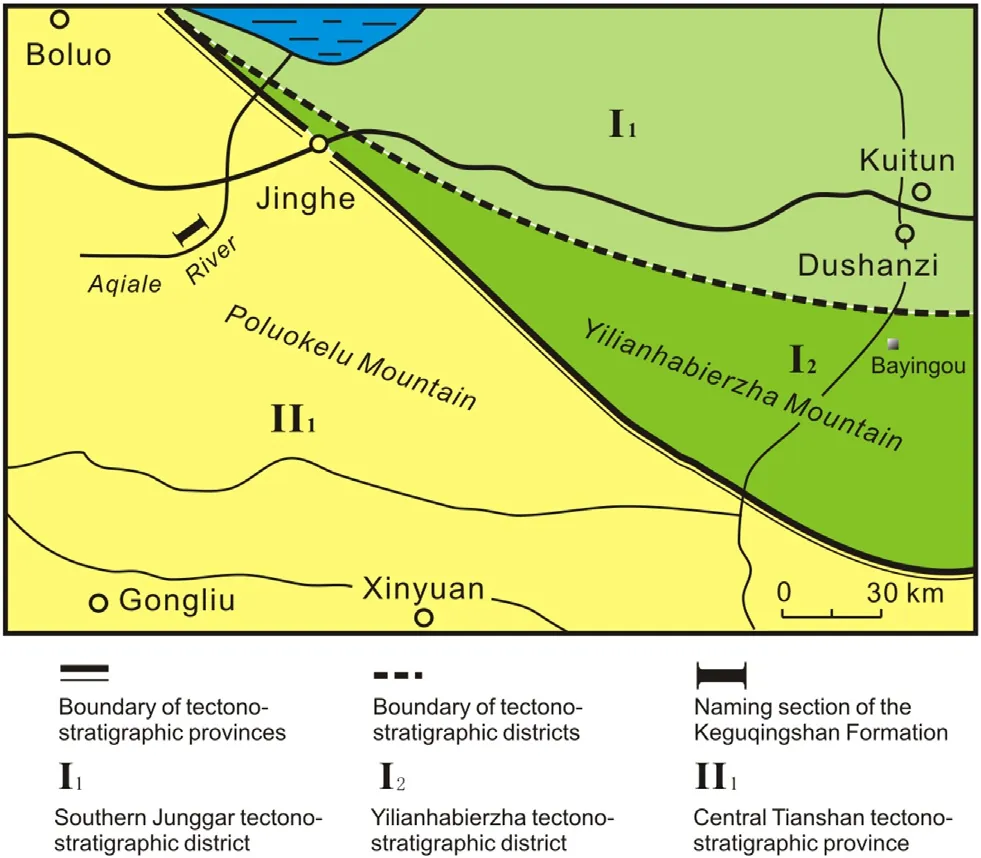
Figure 1-Sketch map showing the Paleozoic stratigraphic provincialism of the eastern-middle Tianshan Mountains region,Xinjiang,Northwest China(after Wang et al.,1994).Note that the BYG area should be re-assigned to the northern Tianshan-Junggar tectonostratigraphic province after the Late Devonian.
To determine if the Gigantoproductus fauna occurs in the BYG complex,we have also undertaken a geological survey in the Bayingou-Haxilegandaban areas(Fig.1)wherethe Anjihai Formation successions are exposed(Liao et al.,2011).No Gigantoproductus elements were found in our collections.Instead,some brachiopod species,namely Schuchertella heishantouensis,Orthotetes sp.,Crurithyris sp.,and Athyris sp.,are present in the Haxilegengdaban area.These brachiopod elements,however,are indicative of a Late Devonian age rather than an Early Carboniferous age.No signs show that the Gigantoproductus fauna occurs in the BYG complex.This inference is also reinforced by Wang et al.'s(1994)clarification that the possible presence of both Gigantoproductus and Semiplanus in BYG was sourced from the earlier geological survey report and was not confirmed by their investigation.Consequently,we considered that the BYG complex belongs to the North Tianshan-Junggar tectonostratigraphic province(cf.Wang et al.,1994)or the Yilianhabierzha oceanic crustal plate(Xiao et al.,1992).The Aibihu-Yilianhabierzha-Xinxinxia Fault,the major fault of the TTC,bounded the southern margin of the BYG complex(Xiao et al.,1992).
2.2.Stratigraphic correlations and palaeobiogeographical implications of the BYG fossil assemblage
Succeeding the Anjihai Formation,the sediments of the Shadawang and Bayingou Formations are distributed along the junction between the Kuitun and Shadawang Rivers and middle and upper cream areas of the Bayingou(Gangou)valley.The Shadawang Formation consists of volcanic lava/basalt,ultrabasic rocks,and radiolarites,yielding the Early Carboniferous radiolarians,while the Bayingou Formation is dominated by black rhymic tuffaceous siltstones of Carboniferous age(Wang et al.,1994).The latter unit was interpreted as a flysch facies succession overlying unconformably on the ophiolites and form the major stratal package of the BYG ophiolite complex together with the Shadawang Formation(Xiao et al.,1992).The upper part of tectonostratigraphic succession of the BYG complex was assigned to the Keguqingshan Group(Wang et al.,1994)including compositionally complicated conglomerates.Tectonostratigraphic succession of the BYG complex represents the sedimentation in environmental settings varying from remnant oceanic crust,remnant oceanic basin to shallow marine and terrestrial successions,exhibiting dynamic evolution of the formation of the BYG ophiolite complex and subsequent orogenic history(Xiao et al.,1992).Here,we have different opinions on the nomenclature of the Keguqingshan Group and correlate the stratal package of the BYG complex differently(Fig.1).
2.2.1.Nomenclature of the Keguqingshan Group
The Keguqingshan Group was established in the Regional Strata Chart of Xinjiang by CGRSCX(1981)based on the succession logged by the No.13 Team of the Soviet Union Geology Survey downstream along the Aqiale River in the Poluokelu Mountain,Xinjiang.The lithology is characterized by the compositionally complicated conglomerates,quartz porphyry interbedded with sandstone and shale in the lower part and the sandstones interbedded with limestones and muddy limestone in the upper part.This group is up to 1350 m thick and has been treated as the marker of the topmost marine beds of the Carboniferous due to the presence of fusulinid foraminifer Schwagerina princes,which is younger than the Moscovian (LateCarboniferous)worldwide(Zhu,1997).Nevertheless,Wu(1991)pointed out that S princes was misidentified in BYG.The author further clarified that the fusulinid fauna younger than the Moscovian has never been reported from the central Tianshan areas(Wu,1991).Our investigation also confirms that no fusulinid zones higher than the Fusulina Zone are recognized in the central Tianshan areas.After a detailed geological survey along the Aqiale River and logging the Carboniferous section in the Suguersu area,we found that the depositional successions at the type section of the Keguqingshan Group in the down stream area of the Aqiale River include various stratigraphic units ranging from the Upper Devonian to Upper Carboniferous in age.The fossilbearing strata in Suguersu are better assigned to the Dongtujinghe Group,a stratigraphic unit widely applied to regional geological survey and mineral exploration practices.The highest marine bed is dated by the presence of the Fusulina Zone.The Keguqingshan Group therefore should be abandoned due to its poor definition(Wu,1991).Consequently,it is inappropriate to apply the abandoned “Keguqingshan Group”to accommodate the conglomerate-dominated succession of molasse facies in BYG(Wang et al.,1994).
Regionally,the BYG conglomerate overlies unconformably the slightly metamorphosed carbonates of the Qijiagou and Aoertu Formations in the areas from the mouth of the BYG valley eastwards to the Anning River.Similarly,a massive conglomerate-volcanic package was found to overlie above the Aoertu Formation carbonates in both the Taodonggou and Taoxigou sections,north of the Turpan Train Station,Turpan City,eastern Xinjiang(Fig.2;Liao et al.,1987).Liao et al.(1987)also proposed the Taoxigou Group to accommodate the conglomerate succession,which is characterized by volcanic brecciaand tuffaceousbrecciawithin thelowerpart,terrestrial siliciclastics within the middle part and andersites within the upper part(Fig.2;Liao et al.,1999).This group is about 1150 m thick and assignable to the molasse facies,indicating tectonic uplift as the result of the Tianshan orogeny(Liao et al.,1999;Liao andLiu,2001).The TaoxigouGroupis not only well exposed along the southern foot of the Bogeda-HaerlikeMountains,butalsoextendswesterlytothe Aiweiergou area of the Yilianhabierzha tectonostratigraphic district.
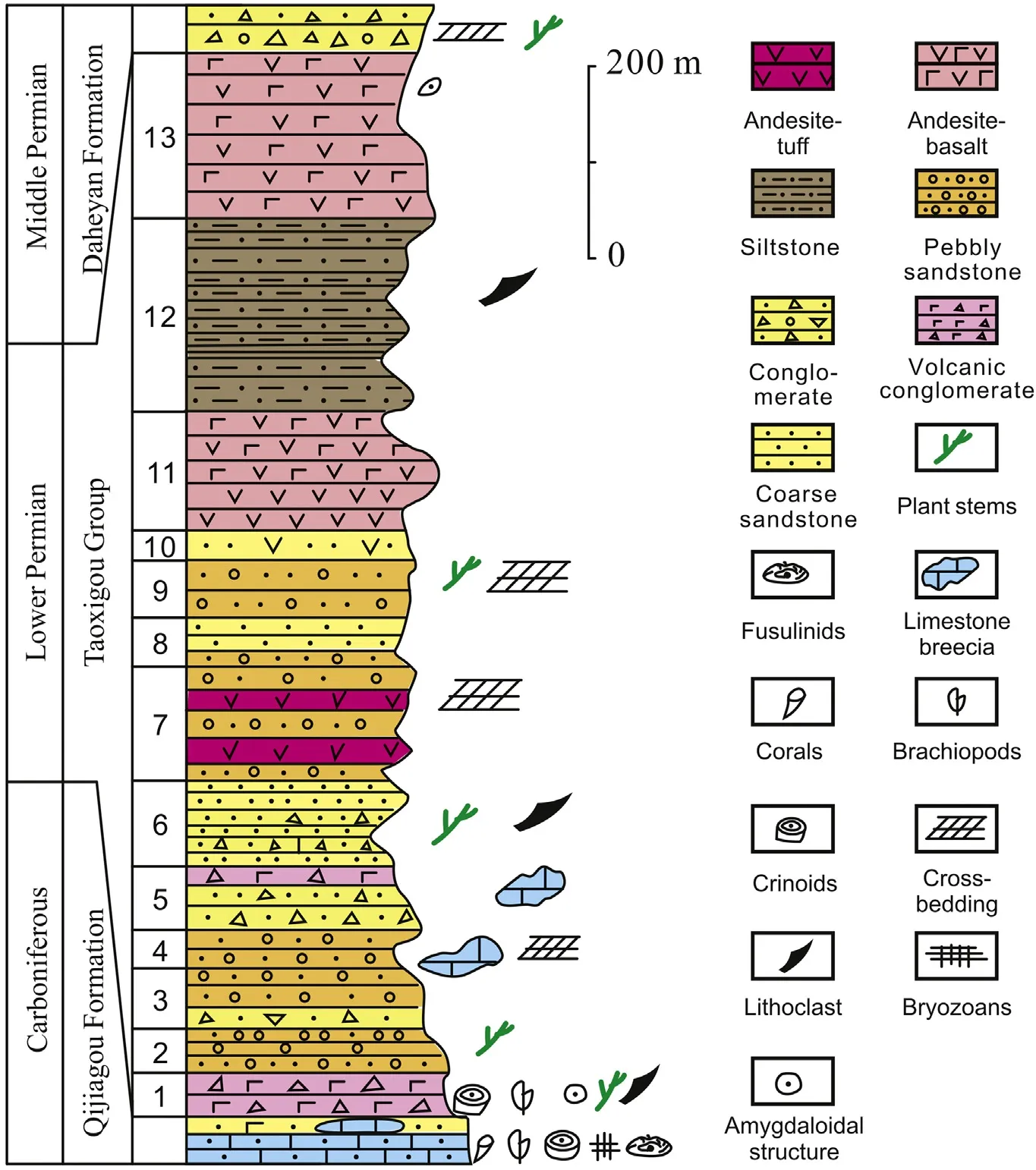
Figure 2-Stratigraphy of the Lower Permian Taoxigou Group at its type section in the Taoxigou valley near the Taoshuyuan train station of Turpan City,eastern Xinjiang.
The Taoxigou Group is widely distributed along the southern foot of the northern Tianshan Mountains from Bayingou,via Aiweiergou eastwards to Taoxigou,Qijiajing and evento Kulai andErdaogou of thenorthernHami area,eastern Xinjiang.This group is characterized by compositionally different conglomerates and breccia and was formed as the result of tectonic uplifts during the Carboniferous-Permian orogeny in this region.All lines of evidence indicate that the Taoxigou Group is more suitable than the“Keguqingshan Group”to accommodate the conglomerate-dominated succession exposed in the BYG complex.
2.2.2.Stratigraphic correlation and palaeobiogeographic implication
The ophiolite m′elange around the Junggar Basin,northern Xinjiang has long been disputed in terms of regional distributions,generictypes,quantity,and formationagesdespiteof four decade-efforts(He et al.,1994;Li et al.,1989;Xiao et al.,1992;Zhang and Zhai,1993).Little has been published on the correlations among these ophiolite belts in northern Xinjiang.Wang et al.(1994)referred the BYG ophiolite m′elange to the Central Tianshan Orogenic Zone and never compared them with the counterparts exposed at the eastern and western margins of the Junggar Basin.However,the BYG complex bears remarkable resemblance with the Dalabute(DLBT)complex of northern Zhayiershan along the northwestern margin of the Junggar Block in terms of tectonostratigraphic successions,faunal assemblages and formation ages.The DLBT complex is the youngest among these complexes(i.e.,Tangbale and Hongguleleng complexes)surrounding the Junggar Block(Wu et al.,1993;Zhang and Zhai,1993).Like the BYG complex,the DLBT complex is also attached to the Junggar Block and records the depositional successions from remnant oceanic crusts,to deep oceanic basin to molasse facies due to oceanic closure and subsequent orogenic uplift.Its tectonostratigraphic succession comprises the Tailegula,Baogutu,Xibeikulashi and Chidi Formations in an ascending order.These depositional units resemble super ficially the Anjihai,Shadawang,Bayingou and Taoxigou Formations of the BYG complex in terms of rock compositions,petrographic texture and depositional settings,indicating that both complexes share similar tectonic background and settings when they were deposited.Accordingly,we consider that the BYG complex is closely af filiated with the northern Tianshan-Junggar Block,not the Central Tianshan Complex Belt as suggested previously(Wang et al.,1994).
More importantly,fossil assemblages from both complexes also share high similarity in faunal compositions and age constraints.As mentioned above,we have detected some fossils from various horizons of the BYG complex depositional successions.For example,considerably abundant fossil assemblages were obtained from the junction between the Shadawang River and the DK highway(Fig.3).It should also be noted that Wang et al.(1994)mentioned abundant benthic fossil assemblages(mainly brachiopods and corals)from the BYG complex.These authors,however,did not list the taxonomic names.They therefore are dif ficult to comparewith our collection.However,both taphonomic states and biofacies of the newly obtained fossils are very similar to these reported from the complexes elsewhere in Xinjiang.The fossil hosting strata comprise rhymic tuffaceous siltstones interbedded with carbonate breccia and conglomerates.These limestone breccias,varying in clast sizes from 1-20 cm in diameter,are comprised of muddy limestone and yield abundant fossils.The fossil assemblage is dominated by the shallow-water faunas of crinoids and brachiopods.Brachiopods are abundant and include:Neospirifer tegulatus(Trautschold),Buxtonia rarirugosa(Licharew),Cancrinella koninckian(Verneuil),Eomarginifera sp.,Linoproductus praelongatus Zhang,Linoproductus simenensis(Tschernyschew),Echinoconchus fasciatus(Kutorga),Phricodothyrissp.,Martiniasp.,Dielasmasp.,and ?Paramuirwoodia sp.Of these,some large brachiopod shells were deposited as independent breccia clasts.In contrast,the matrix rocks are dominated by rhymic siltstone suggestive of a deep-water depositional environment.Accordingly,these benthic faunas inhabited originally shallow-water settings and were latertransportedto the deep-watersettings together with limestone breccia.
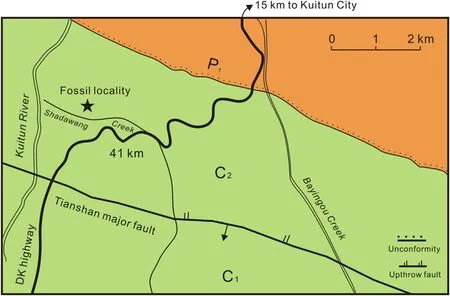
Figure 3-Fossil locality of the Bayingou(BYG)ophiolite m′elange near Kuitun City,Xinjiang(after Wang et al.,1994).C1=Lower Carboniferous;C2=Upper Carboniferous;P1=Lower Permian;DK=Dushanzi-Kuqa.
OftheBYGbrachiopodfauna,severalelements,includingN tegulatus,B rarirugosa,C koninckian,L praelongatus,E fasciatus,and?Paramuirwoodiasp.areverycommonintheBashkirianto Moscovian strata in Xinjiang and elsewhere in Central Asia(Chen,2004;Chen and Shi,2001,2003b;Liao,1995;Yang,1964;Zhang et al.,1983).Surprisingly,similar sedimentary package and faunal assemblages were also detected in the Bagutu and Xibeikulashi Formations of the Zhayiershan area of western Junggar region.For example,we have also found the reworked limestone breccia bearing benthic fossils,which are interbedded within the rhymic siltstone-dominated flysch facies succession at the Liudonggou section near Liushugou and the type section of the Xibeikulashi Formation near the Xibeikulashi area of Tuoli County(Liao et al.,1990a).The Tuoli fossil assemblage is also dominated by shallow-water benthic faunas of crinoids and brachiopods.Of these,brachiopods are similar to those of the BYG complex.Both of them are characteristic of the early Late Carboniferous faunas of the Junggar-Xingan Province(Liao,1995;Yang,1990).In contrast,the matrix sediments of both the Bagutu and Xibeikulashi Formations,together with the underlying Tailegula Formation,are generally believed to represent deep-water turbidites(Jing,1989;Liao et al.,1993;Wu et al.,1993).Accordingly,these shallow-waterbrachiopodandcrinoidfossilsweretransported from shallow habitats and deposited in deep-water settings.All lines of evidence show that the BYG complex resembles remarkably the DLBT complex in tectonostratigraphic successions and faunal assemblages.Both complexes represent the youngest orogenic suture belts around the margins of the Junggar remnant oceans during the early Late Carboniferous.Therefore,the BYG complex has been likely part of the northernTianshan-JunggarBlocksincetheLateDevonian,although it may be part of the Central Tianshan tectonostratigraphic province prior to the Late Devonian(Wang et al.,1994).
3.Permian-Triassic tectonostratigraphic successions of the Aiweiergou area and implications for tectonic interpretation of the Tianshan complex
The Aiweiergou(AWEG)is located about 120 km south of the Urumqi City,capital of Xinjiang Uygur Autonomous Region,northwest China(Fig.4).AWEG is well-known for the coal mine,whichhasbeenoperatedsincethe1950s.Inthisarea,the Permian,TriassicandJurassicstrataarewellexposedwithcoal measures occurring in the Jurassic succession.The Permian and Triassic successions are separated by a regional unconformity along the entire southern margin of the Junggar Basin.Thisunconformityismarkedbythecoarseconglomerateofthe Karamay Formationoverlying on various units of Middle-Late Permian ages.More recently,an in fluential study addressing on the Central Asian tectonic evolution(Xiao et al.,2008)has drawnourattention.Inthatstudy,Xiaoetal.(2008,p.108,op.cit.Fig.4)interpreted theUpperPermianclasticsexposednearthe 106 km milestone marker of the Urumqi-AWEG(UA)highway as deep-water turbidites.These authors have also interpreted the unconformity between the Upper Permian clastics and the overlying Karamay Formation of the Middle-Late Triassic age as the evidence of closure of Tianshan Ocean and subsequent consolidation between the Tarim Block and the accreted Siberian-Junggar palaeo-Plate.As such,Xiao et al.(2008)inferred that the Tarim Block was accreted to the accreted Siberian Craton during the latest Permian to Triassic.Here,we interpret differently the Permian sedimentary settings of this area and their tectonic implications.
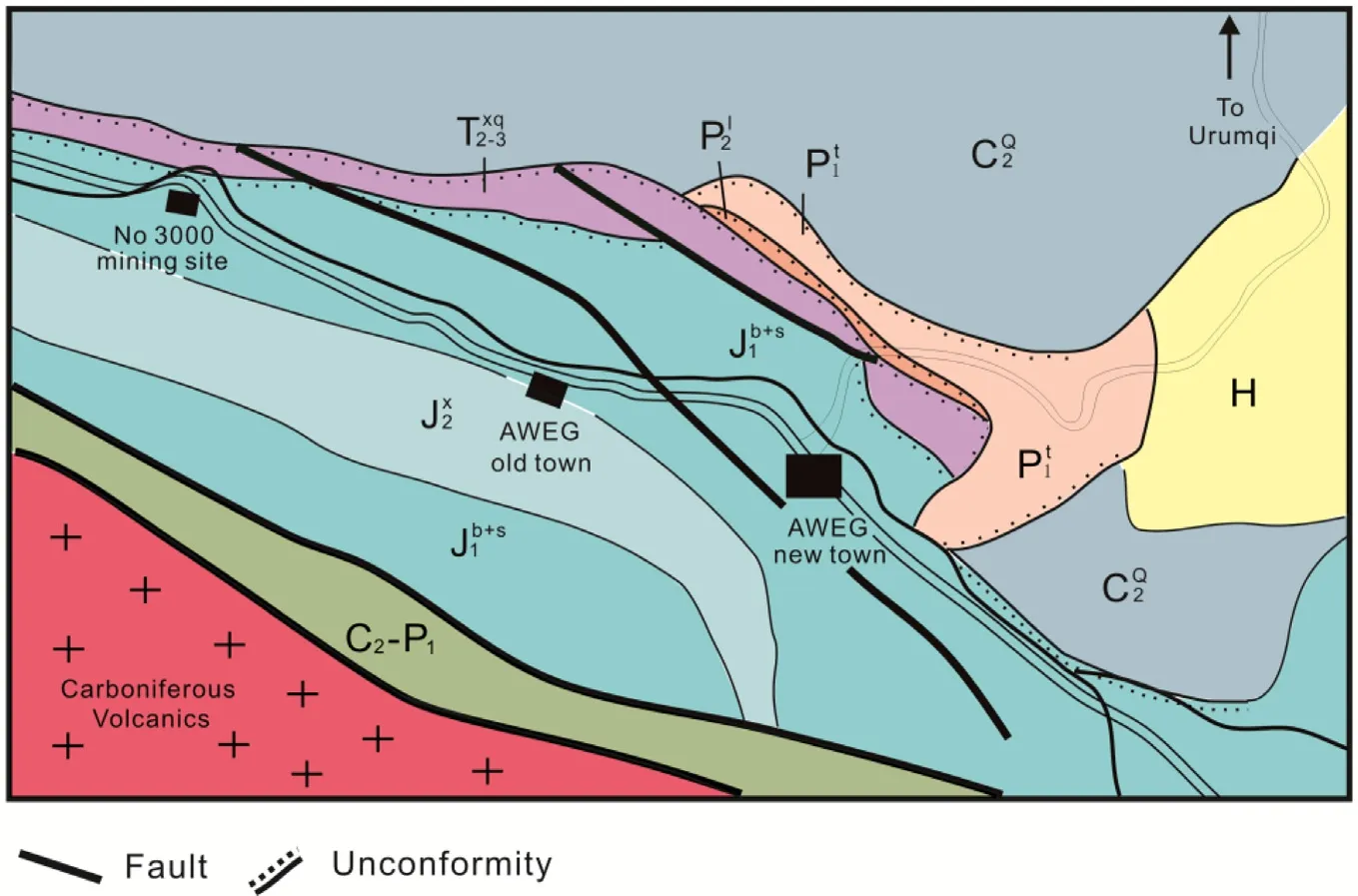
Figure 4-Geological map of the Aiweiergou(AWEG)area,South Urumqi,Xinjiang.=Upper Carboniferous Qijiagou Formation;C2-P1=Upper Carboniferous-Lower Permian rocks;=Lower Permian Taerlong Formation;=Middle Permian Lucaogou Formation;=Middle-Upper Triassic Xiaoquangou Group;=Lower Jurassic Badaowan and Sangonghe Formations;=Middle Jurassic Xishanyao Formation;H=Holocene rocks.
3.1.Permian-Triassic stratigraphy in AWEG
Geological surveys in AWEG have been conducted to search for coal resources since the 1950s.The Northwest Petroleum Exploration Bureau assigned the Permian and Triassic sediments to the Yaomoshan and Xiaoquangou Groups for the first time,respectively in the mid-1950s.The former unit represents the Upper Permian succession,while the Xiaoquangou Group includes the Middle-Late Triassic successions.This stratigraphic subdivision has been followed by later studies(i.e.,CGRSCX,1981).However,Zhang and Wu(1991)correlated the Permian and Triassic successions of AWEGwith these exposedin the northernTaoshuyuanarea of Turpan City and applied the Taodonggou Group(including the Daheyan and Taerlong Formations)to include the lower part of the Upper Permian succession,the Xiachangfenggou Group(Quanzijie and Wutonggou Formations)for the upper part of the Upper Permian succession,and the Xiaoquangou Group for the Middle-Upper Triassic sediments.
In AWEG,the lower part of the Permian succession is characterizedbyvolcanics,volcanicconglomeratesand coarse terrestrial clastics(Fig.5),which were previously assigned to the Daheyan Formation of the Taodonggou Group(CGRSCX,1981).However,these rocks are very different from the lithology of the typical Daheyan Formation,which is characterized by fluvial facies consisting of coarse sandstone and conglomeratic sandstone.In contrast,the AWEG depositional package is indicative of a molasse facies succession and assignable to the Taoxigou Formation of the Turpan area,eastern Xinjiang (Fig.2).Here,both macro floraland micro floral assemblages derived from the upper part of the Taoxigou Group suggestan Asselian-Sakmarian (Early Permian)age for the unit(Liao et al.,1999).
Overlying the Taoxigou Group,a thick succession of black shale was deposited and they were previously ascribed to the Taerlong Formation(Hu et al.,1991;Zhang and Wu,1991).This succession is lithologically distinguished from that of the Taerlong Formation at its type section in the Taoshuyuan area,but is similar to that of the contemporaneous Lucaogou Formation exposed at the northern foot of the Bogda Mountains.These rocks were therefore re-assigned to the Lucaogou Formation(Liao and Liu,2001;Liao et al.,1999).The Lucaogou Formation yields abundant conchostracans,ostracods,bivalves,gastropods, fishes,plants,and micro flora of early Roadian(Middle Permian)age(Liao and Liu,2001;Ouyanget al.,2003).Changes of stratigraphic subdivision of the Permian and Triassic successions at AWEG are listed on Table 1.
The Lower Triassic is absent in AWEG.The Middle-Late Triassic Xiaoquangou Group includes the Karamay,Huangshanjie and Haojiagou Formations.Abundant conchostracans,bivalves,ostracods,gastropods,insects,and plants have been obtained from the middle-upper Karamay Formation,and Huangshanjie and Haojiagou Formations,and constrain the Karamay Formation as middle-late Triassic in age and both Huangshanjie and Haojiagou Formations as Late Triassic in age(Table 1;Liao and Liu,2001).
Accordingly,the “Upper Permian turbidite”exposed in AWEG described by Xiao et al.(2008)should be the alternating shale and sandstone of the early Middle Permian Lucaogou Formation(Fig.6),while the Late Triassic conglomerate and sandstone should be the Middle-Late Triassic Karamay Formation(Table 1).It should also be noted that age constraints of stratigraphic units described at Stops 7-1 to 7-5 and illustrated by Wang et al.(2010,p.263, fig.13A,B)are incorrect.Of these,the conglomerates illustrated by Wang et al.(2010,op.cit. fig.13A)should be Early Permian in age,not Late Carboniferous as noted by Wang et al.(2010,op.cit. fig.13A).These rocks should be assigned to the Taoxigou Group(Table 1).Their Fig.13B(Wang et al.,2010)shows the Middle-Late Triassic terrestrial rocks overlying unconformably the early Middle Permian lake-facies succession.
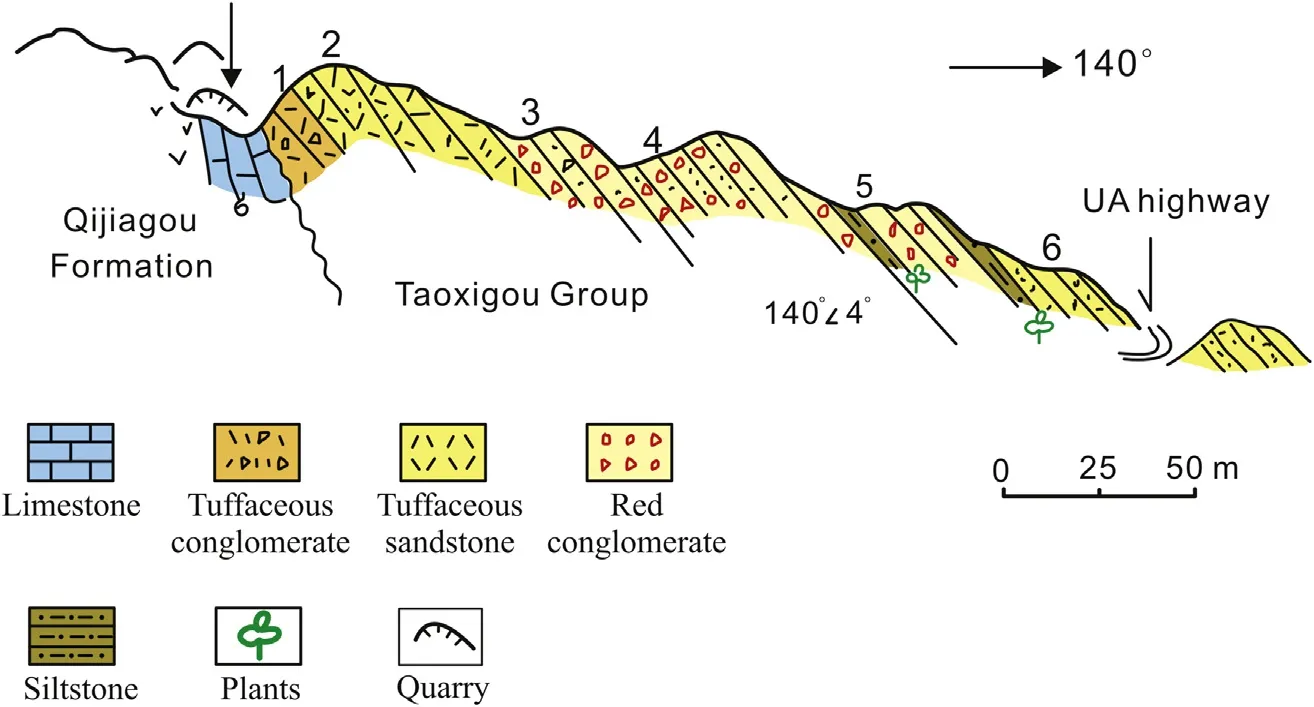
Figure 5-The Taoxigou Group molasse-type succession exposed near the 85 km milestone along the Urumqi-Aiweiergou(UA)highway in the AWEG area.
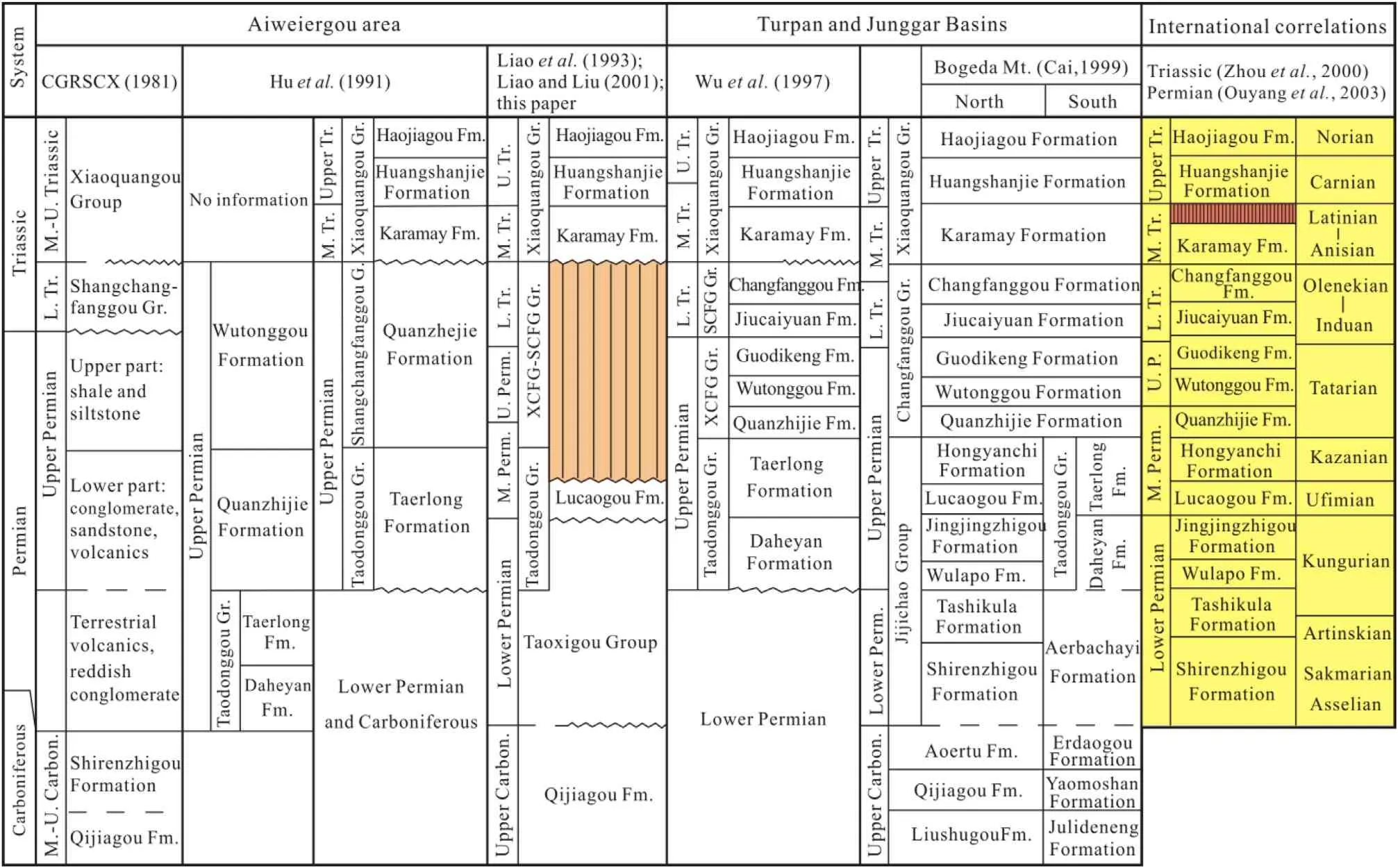
Table 1-Stratigraphic subdivision schemes and correlations of the Permian and Triassic stratigraphic units in the AWEG area,Urumqi City,Xinjiang XCFG Gr.=Xiao Changfanggou Group,SCFG Gr.=Shang Changfanggou Group.
3.2.Depositional environment of the Middle Permian succession in AWEG
In AWEG,the Lucaogou Formation is a black shale-dominated succession with minor interbeds of thin-bedded siltstone,muddylimestoneanddolomiticlimestone(Hou,2000).Abundant conchostracans,ostracods,bivalves,gastropods,fishes,plants,and micro flora(Hou,2000;Su et al.,2006b;op.cit.fig.3 and pl.1)are typical of the terrestrial assemblage(Liao and Liu,2001).The black shales of the Lucaogou Formation are very thin,paper-like in sharp contrast to the overlying reddish conglomerate-dominated Karamay Formation in the field.The unconformity between these two units therefore is very conspicuous at the No.106 km milestone marker(previously,94 km milestone in the 1990s)of the UA highway(Fig.6),as illustrated by Xiao et al.(2008,op.cit. fig.4)and Wang et al.(2010,op.cit. fig.13B).As such,the so-called Upper Permian “turbidite”deposits actually belong to the lacustrine facies succession of early Middle Permian age.In fact,there are no Permian and Triassic marine sediments present in AWEG where the Permian and Triassic successions represent fluvial to lake facies sedimentation(Hou,2000;Su et al.,2006a).
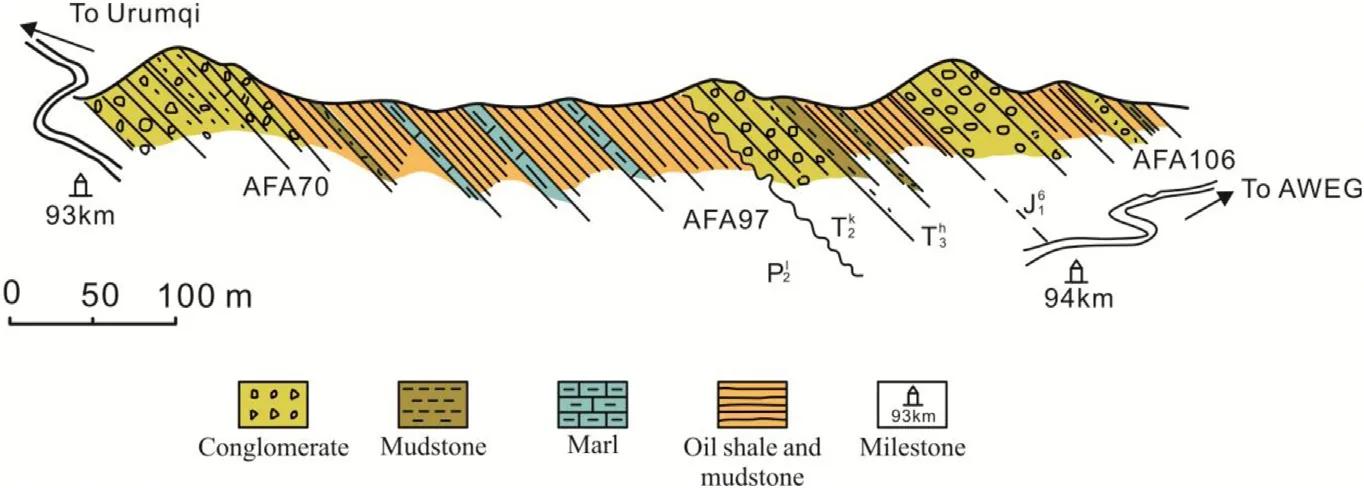
Figure 6-Permian-Triassic successions exposed between 93 km and 94 km milestones along the Urumqi-Aiweiergou(UA)highway in the AWEG area.Note that an unconformity is pronounced between the early Middle Permian Lucaogou Formation and the Middle-Late Triassic conglomerate of the Karamay Formation.=Middle Permian Lucaogou Formation;=Middle Triassic Karamay Formation;=Upper Triassic Huangshanjie Formation;=Lower Jurassic Badaowan Formation.
3.3.Permian-Triassic unconformity in AWEG and its regional tectonic implications
The unconformity beneath the Karamay Formation is not only pronounced in AWEG(i.e.,at the site near the No.106 km milestone marker of UA highway;see Xiao et al.,2008;op.cit.fig.4),but also is well exposed in entire southern margin areas of the Junggar Basin(CGRSCX,1981;Zhang and Wu,1991).At the coal mining site within the western AWEG,this unconformity is defined by the Karamay Formation overlying the Lower Permian volcanics and clastics of the Taoxigou Group or the carbonates of the Carboniferous Qijiagou Formation(Fig.7).This unconformity is characterized by the Late Triassic Huangshanjie Formation overlying the Carboniferous volcanics eastwards to Keerjian coal mines and western Hongshanzui area.Therein the Karamay Formation is absent.In the Turpan-Hami Basin,east of the AWEG,the conglomerates of the Karamay Formation unconformably overlie the Lower Triassic Changfanggou Formation in the Taodonggou,Kekeya and Zhaobishan areas(CGRSCX,1981;Liao et al.,1987,1998;Thomas et al.,2011;Yang et al.,2007,2010;Zhang and Wu,1991;Zhou et al.,2000).Similarly,the Karamay Formation overlies unconformably the Lower Triassic terrestrial strata or even older non-marine(or marine)strata in many areas of the southern margins of the Junggar Basin(CGRSCX,1981;Hu et al.,1991;Liao et al.,1987,1998;Ouyang et al.,2003;Wu et al.,1997a;Zhang and Wu,1991;Zhou et al.,2000).Clearly,the unconformity between the Permian black rocks and Triassic reddish strata seen in AWEG(Xiao et al.,2008;op.cit.fig.4)represents a tectonic uplift event which took place in terrestrial basins of theaccreted Junggar blocksduring the late Early Triassic to early Middle Triassic times.Prior to the formation of the unconformity,a thick succession of molasse to fluvial to lacustrine facies was deposited during the Early Permian to Early Triassic.This uplift event is therefore much younger than the orogenic uplift events of the Tianshan orogeny indicated by the Early Permian molasse-type sediments(see below).
3.4.Taoxigou Group and its regional tectonic implications
Previously,Huang et al.(1990)inferred that the closure of the north Tianshan Ocean started in late Middle Carboniferous.The molasse facies sediments were deposited in the orogenic belt during the Late Carboniferous,while the north Tianshan ophiolite m′elange is the last suture zone between the Siberian and Tarim plates and consolidation between these two plates took place in the end of the Carboniferous(Huang et al.,1990).Xiao et al.(1992)considered that north Tianshan and south Tianshan remnant oceanic basins were closed during the Late Carboniferous to Early Permian times.At the same time,these Paleozoic individual continental blocks consolidated together to form a complete continental block(Xiao et al.,1992).Similarly,Chen et al.(1993)constrained the closure time of the north Tianshan and western Kunlun oceanic basins as the Early Permian with coeval terrestrial acidic volcanism widespread over the Tianshan region.Ma et al.(1993)inferred that the north Tianshan oceanic basins including the Yilianhabierzha-Bogda-Haerlike Mountains were closed during the Late Carboniferous.He et al.(1995)considered that the Yilianhabierzha area uplifted to a terrestrial setting during the Permian.Li et al.(2006)believed that the Tianshan oceans were closed during the Late Carboniferous,neither earlier nor later.Su et al.(2006a,2006b)confirmed that no marine sediments were deposited in the Tianshan areas since the Late Carboniferous.Radiometric datingdata suggestthat the South Tianshan orogeny is a Late Paleozoic collisional orogenic belt,not a Triassic one(Gao et al.,2009;Su et al.,2010).
As outlined above,the Taoxigou Group represents the first conglomerate unit since ebb of the sedimentation of marine sediments in Late Carboniferous in the TTC.This group usually overlies unconformably various units of different ages along the southern margins of the Junggar Basin,northern Xinjiang.Thus,the depositional environment of the Taoxigou Group is of particular importance in interpreting orogenic events in the TTC.
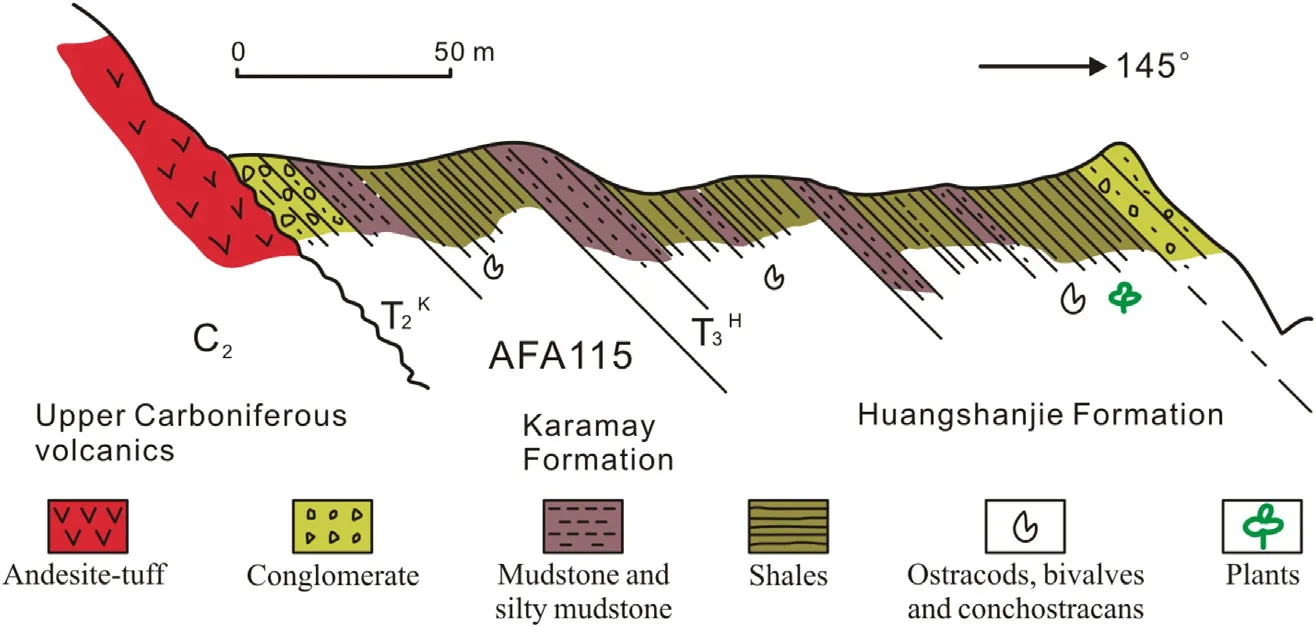
Figure 7-Triassic succession exposed in the No.3000 mining site of the Aiweiergou area showing the Triassic rocks unconformably overlying the Upper Carboniferous volcanic rocks.=Middle Triassic Karamay Formation;=Upper Triassic Huangshanjie Formation.
The Taoxigou Group comprises chie fly volcanic,terrestrial clastics and volcanic breccia/conglomerates at its type section in the Taoxigou section,north of the Taoshuyuan area of Turpan City(Fig.2),in which this group contacts unconformably the underlying Carboniferous carbonates and overlying Middle Permian clastics.This group also includes the depositional package underneath the Daheyan Formation previously assigned to the Carboniferous(CGRSCX,1981;Zhao,1980)in the Taodonggou section of the Taoshuyuan area(Liao et al.,1999).Its equivalent has been found not only in theAWEGandBYG areas,but alsointhemiddleandeastern parts of the Turpan-Hami Basin,eastern Xinjiang(Liao et al.,1999).Both the macro floral and micro floral assemblages constraintheTaoxigouGroupinAWEG asanAsselian-Sakmarian(Early Permian)age(Liao et al.,1999).
As stated above,the youngest ophiolite m′elange in the TTC is Late Devonian in age.The overlying turbidite succession,yielding a Bashkirian-Moscovian fossil assemblage,indicates that the remnant oceans still existed until the early Late Carboniferous.Regionaldepositional gapsin theTTC occurred in the Kossmovian-Gzhelian(late Late Carboniferous)interval.In the Early Permian,the molasse succession of the Taoxigou Groupwas deposited in the TTC.The latter therefore marks the final closure of the Tianshan Ocean and consolidation between the Tarim Block and accreted Junngar-Siberian palaeo-Plate.This inference is consistent with the previous tectonic interpretations(He et al.,1995;Huang et al.,1990;Ma et al.,1993;Xiao et al.,1992).
After a two-decade geological survey in the Tianshan Mountains, Xinjiang, we have logged the Carboniferous-Permian sections in Qijiagou,Aiweiergou,Mishigou,Kumishi,Pochengzhi(Keziletage),Bayingou,Bayinbuluke,Erxiangqiao,and Kongchun areas and systematically studied the biostratigraphy of the Carboniferous-Permian sequences with an emphasis on their differences in depositional cycles,sedimentary settings,faunal assemblages and palaeobiogeographic af finities.Geological investigations in middle and western parts of the Tianshan Mountains and Beishan region near the Xinjiang-Gansu junction enable us to reconstruct the palaeogeographic evolutions of the entire Tianshan Mountains region during the Carboniferous-Permian times.Prior to the early Late Carboniferous,most areas of the Tianshan Mountains were oceanic settings ranging from deep basin to shallow seas.The Late Carboniferous was a critical period for palaeogeographic evolutions of the TTC.Massive regressions in this vast region are indicated by the presence of coarse nearshore facies or high-evaporitic lagoon facies successions in many places.During the Permo-Carboniferous transition,sea water further retreated from the middle part of the Tianshan Mountains between the DK highway and the Bogeda-Tuokexun-Kumishiline.Theintralandorforelandmolasse sedimentsweredepositedalongtheYilianhabierzhaMountain,the core of the north Tianshan Mountains,and the southern footsoftheBogedaHaerlikeMountainsatthattime.Thus,these areas were uplifted to continents in the earliest Permian.
In addition,the Early Triassic Erhobulake Formation from the Kuqa area,northern margin of the Tarim Basin is characterized by a conglomerate-dominated coarse clastic succession(CGRSCX,1981).These coarse clastics have been often treated as evidence indicating the basal conglomerates of a foreland basin,which implies that the South Tianshan consolidation and orogenesis occurred in the Early Triassic(Li et al.,2010).However,the Erhobulake Formation at its type section in the Biyoulebaguzhi gulley,northwest of the Kuqa County overlies unconformably the terrestrial facies of the BiyoubaguzhiGroup oftheMiddle-LatePermian age(CGRSCX,1981;Liao et al.,1990b;Wu,1993;Wu et al.,1997b;Xinjiang Bureau of Geology and Mineral Resources,1999).The latter yields abundant terrestrial plants and ostracods of Roadian-Changhsingian age(Wu et al.,1997b).This means that terrestrial successions have been deposited prior to the deposition of the Erhobulake conglomerates.The Biyoubaguzhi Group in Kuqa is very similar to the Permian succession exposed in AWEG.Thus,the marine Middle-Late Permian successions are absent in the southern Tianshan Mountains region.If the Biyoubaguzhi Group and Erhobulake Formation represent the sedimentation results of post-orogenesis,the uplifting orogenic event must have taken place prior to the Middle Permian in the south Tianshan Mountains region.Accordingly,all lines of evidence from both sides of the Tianshan Mountains indicate that the closure of the Tianshan Ocean and subsequent orogenic uplifting occurred in the Permo-Carboniferous transition.
4.Conclusions
The Bayingou(BYG)ophiolite m′elange,eastern Tianshan Mountains is Late Devonian to Early Carboniferous in age.Likely,the BYG complex has been part of the northern Tianshan-Junggar Block since the Late Devonian,although it may be part of the Central Tianshan tectonostratigraphic province prior to the Late Devonian.
The uppermost strata of the BYG ophiolite m′elange are reassigned to the Early Permian Taoxigou Group instead of the Keguqingshan Formation.The latter unit should be abandoned.The BYG ophiolite m′elange succession comprises the Late Devonian AnjihaiFormation,the Carboniferous Bayingou and Shadawang Formations,and the Early Permian Taoxigou Group.
ThePermian-Triassicsuccession oftheAiweiergou(AWEG)area,eastern Tianshan Mountain region comprises the Lower Permian Taoxigou Group,the Middle Permian Lucaogou Formation,and the Middle-Late Triassic Karamay Formation and Late Triassic Huangshanjie and Haojiagou Formations.All of these stratigraphic units represent Permian and Triassic terrestrial deposits.
The ‘Upper Permian turbidite sediments’illustrated in previous publications should be lacustrine facies deposits of the early Middle Permian Lucaogou Formation.The unconformity between the Permian and Triassic rocks in AWEG cannot indicate the closure of the Tianshan Ocean,and instead,is the result of uplifting in the foreland basins.
The molasse-type sediments of the Early Permian Taoxigou Group in AWEG area can be interpreted as the result of tectonic uplift due to the closure of the south Tianshan Ocean prior to the Early Permian.This tectonic inference agrees well with faunal assemblages from both sides of the TTC and the previous tectonic inferences in that region.Accordingly,the closure of the South Tianshan Ocean and tectonic accretion of tectonic blocks in the Tianshan Mountains might have taken place during the Permo-Carboniferous transition.
Acknowledgements
We thank Profs.Zhao-Qi Yao,Zhao-Sheng Liu,and Yan-Bin Shen providing assistance in the field and discussions on biostratigraphy of the Tianshan Mountains region.We are also grateful to both Hao-Ruo Wu and Jin-Hua Jia for their critical comments and constructive suggestions which have improved greatly the quality of the paper.This study is supported by aid grants from the State Key Laboratory of Biogeology and Environmental Geology(GBL11206),and the Geological Process and Mineral Resources(GPMR201504),China University of Geosciences(Wuhan)(GBL11206).
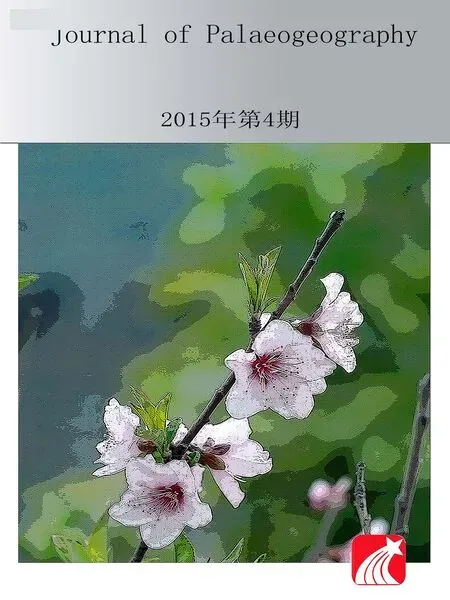 Journal of Palaeogeography2015年4期
Journal of Palaeogeography2015年4期
- Journal of Palaeogeography的其它文章
- Sedimentary facies and lithologic characters as main factors controlling hydrocarbon accumulations and their critical conditions
- Calcareous nannoplankton dating of the Late Quaternary deposits in Greece and the eastern Mediterranean:Case studies from terrestrial and marine sites
- Lithofacies palaeogeography of the Carboniferous and Permian in the Qinshui Basin, Shanxi Province, China
- Modeling the Middle Jurassic ocean circulation
- Correction of two Upper Paleozoic stratigraphic units in the Tianshan Mountains region, Xinjiang Uygur Autonomous Region and implications on the Late Paleozoic evolution of Tianshan tectonic complex,Northwest China
- End-Triassic nonmarine biotic events
